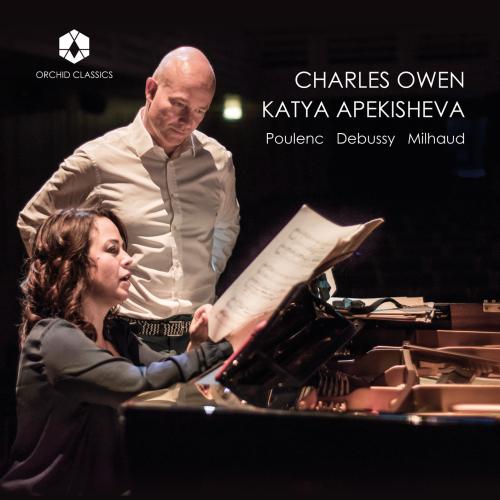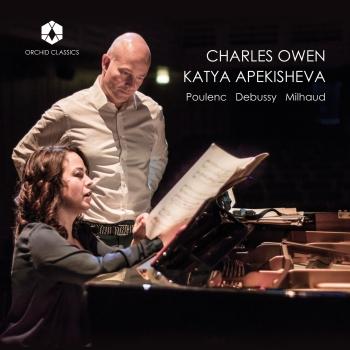
Poulenc, Debussy & Milhaud: Works for 2 Pianos Charles Owen & Katya Apekisheva
Album info
Album-Release:
2023
HRA-Release:
17.11.2023
Label: Orchid Classics
Genre: Classical
Subgenre: Instrumental
Artist: Charles Owen & Katya Apekisheva
Composer: Darius Milhaud (1892-1974), Francis Poulenc (1899-1963), Claude Debussy (1862-1918)
Album including Album cover
- Darius Milhaud (1892 - 1974): Scaramouche, Op. 165b:
- 1 Milhaud: Scaramouche, Op. 165b: I. Vif 02:52
- 2 Milhaud: Scaramouche, Op. 165b: II. Modéré 03:53
- 3 Milhaud: Scaramouche, Op. 165b: III. Brazileira 02:24
- Francis Poulenc (1899 - 1963): Capriccio, FP 155 (After Le bal masqué, FP 60):
- 4 Poulenc: Capriccio, FP 155 (After Le bal masqué, FP 60) 04:57
- Sonata for Piano 4 Hands, FP 8:
- 5 Poulenc: Sonata for Piano 4 Hands, FP 8: I. Prelude 01:59
- 6 Poulenc: Sonata for Piano 4 Hands, FP 8: II. Rustique 01:51
- 7 Poulenc: Sonata for Piano 4 Hands, FP 8: III. Final 01:53
- Élégie for 2 Pianos, FP 175:
- 8 Poulenc: Élégie for 2 Pianos, FP 175 05:36
- Sonata for 2 Pianos, FP 156:
- 9 Poulenc: Sonata for 2 Pianos, FP 156: I. Prologue 05:59
- 10 Poulenc: Sonata for 2 Pianos, FP 156: II. Allegro molto 04:59
- 11 Poulenc: Sonata for 2 Pianos, FP 156: III. Andante lirico 05:41
- 12 Poulenc: Sonata for 2 Pianos, FP 156: IV. Épilogue 04:26
- L'embarquement pour Cythère, FP 150:
- 13 Poulenc: L'embarquement pour Cythère, FP 150 02:15
- Claude Debussy (1862 - 1918): Nocturnes, L. 91 (Arr. for 2 Pianos by Maurice Ravel):
- 14 Debussy: Nocturnes, L. 91 (Arr. for 2 Pianos by Maurice Ravel): No. 1, Nuages 06:09
- 15 Debussy: Nocturnes, L. 91 (Arr. for 2 Pianos by Maurice Ravel): No. 2, Fêtes 06:04
- 16 Debussy: Nocturnes, L. 91 (Arr. for 2 Pianos by Maurice Ravel): No. 3, Sirènes 09:37
Info for Poulenc, Debussy & Milhaud: Works for 2 Pianos
Darius Milhaud was the most irrepressible and eclectic member of a group of composers coined popularly in the press as ‘Les Six’ – the other members were Auric, Durey, Honegger, Poulenc, and Tailleferre. Although each had their own indelible musical personality, they shared a common view that the old Romantic order had outlived its usefulness and that contemporary music needed a good spring-clean. The classics of yesteryear were light-heartedly rethought in the context of a new playfulness, textural pungency, and madcap humour. It wasn’t long before jazz too was thrown into the Gallic melting pot as a refreshing antidote to Teutonic heaviness. Its nervous brilliance, enlivened by unconventional rhythmic accents and pared-down instrumentation, was in complete accord with the reaction against Romanticism that had set in before the end of World War I.
Milhaud embraced the idea of polytonality – music in more than one key at the same time – as early as 1916, and then began experimenting with speech and choral effects such as whistling, groaning, and shrieking. Trips to America enriched his musical language still further with jazz, the blues, and catchy dance rhythms, while his capricious word-settings based on catalogues of flowers and agricultural machinery kept disapproving critical pencils well-sharpened. The three-movement suite Scaramouche, based on existing music borrowed from two theatrical scores, was named after the Théâtre Scaramouche, which specialised in whimsically inventive dramas for children. It subsequently became Milhaud’s most popular work, yet he initially thought so little of it he considered forbidding its publication.
The archetypal 20th-century French composer, Poulenc combined grace and sparkling wit with a gentle nobility that encapsulated his desire for a ‘return to simplicity’. The key to his creative world lies hidden in a biographical note sent to his English publisher when he had just turned 19: ‘I studied composition almost solely through books because I was fearful of being influenced by a teacher…My four favourite composers, my only masters, are Bach, Mozart, Satie and Stravinsky. In general, I am very eclectic… I am a musician without a label.’
The Élégie is dedicated to the memory of celebrated patron of the arts, Princess Marie-Blanche de Polignac, and written ‘as if improvising with a cigar in your mouth and a glass of cognac on the table’ for ‘les boys’: Arthur Gold and Robert Fizdale. So too the Capriccio, transcribed from the finale of Poulenc’s dazzlingly surreal cantata La bal masque, and the insatiable waltz L’embarquement pour Cythère, adapted from his music to the film Le voyage en Amérique and based on Watteau’s eponymous painting depicting several couples being enticed to Cythera, the Isle of Love.
‘I know perfectly well that I’m not one of those composers who have made harmonic innovations like Igor [Stravinsky], Ravel or Debussy,’ wrote Poulenc in 1942, ‘but I think there’s room for new music which doesn’t mind using other people’s chords. Wasn’t that the case with Mozart and Schubert?’ Of all the composers Poulenc might have chosen to make his point, they were especially apposite as the tantalising emotional thrust of his music, which at times appear to hover midway between elation and despair, brings those particular composers immediately to mind. Just three years before, Poulenc had revised his early Sonata for Four Hands, whose finger-crossing intricacies were reputedly designed to subtly enhance his contact with a student of whom he was particularly fond at the time.
Typical of Poulenc’s neoclassical tendency to use the composing greats as a springboard for his own creative imagination, the Sonata for Two Pianos was premiered at the Wigmore Hall on 2 November 1953. In a brief accompanying programme note, Poulenc explained ‘I began with the Andantino, knowing already the overall architecture of the work. Framed by a Prologue, an Allegro molto and an Epilogue, for me this Andantino is the very heart of the work… a lyrical, profound outburst…It is piano without pretence, real piano where each instrument converses with the other in perfect understanding and without interrupting.’
Debussy was music’s gentle revolutionary. If Stravinsky emancipated rhythm as a primeval force of nature, and Schoenberg embraced atonality (keylessness) and serialism, Debussy was content to gently loosen the bonds of orthodoxy. Listen to almost any of Debussy’s late piano pieces and you’ll be hard-pressed to say exactly what key it is in, let alone its time signature or detect anything so obvious as a singable melody. But whereas his colleagues announced their musical credentials with almost brute force, Debussy approached by stealth, cocooning his audiences in a sensual web of textures and sonorities that appeared to suspend time and place. ‘Everything with me is instinctive and unreasonable,’ he once declared. ‘I have no experience at all – only instinct.’
Debussy’s highly individual style of composing rang alarm bells as early as his training at the Paris Conservatoire. Emile Réty, the registrar, once asked him: ‘So you imagine that dissonant chords do not need to be resolved. What rule do you follow?’ – ‘Mon plaisir!’ came the disarming reply. Following a visit to the Bayreuth Festival, where he fell under the spell of Wagner’s music, and his contact with the music of the Far East through the Paris Exhibition of 1889, Debussy began considering the use of ‘ambiguous chords that belong to as many keys as one likes’ and ‘incomplete chords with floating intervals’. One can already sense the sea-change in the three orchestral Nocturnes he completed in 1899, inspired by a series of paintings by the American painter, James Whistler.
Debussy described the Nocturnes, performed here in Ravel’s 1901 transcription for two pianos, as ‘an exploration of the different combinations which particular colours can produce…Nuages portrays the unchanging aspect of the sky and the slow melancholic passing of clouds… Fêtes represents the movement, the dancing rhythm of the atmosphere with sudden flashes of light… Sirènes depicts the sea and its countless rhythms, and then amidst the waves, silvered in the moonlight, the mysterious song is heard of the sirens as they laugh and pass on.’
Katya Apekisheva, piano
Charles Owen, piano
Charles Owen
enjoys an extensive international career performing a wide-ranging repertoire to outstanding critical acclaim. He appears at many major UK venues such as Wigmore Hall, Bridgewater Hall, The Sage & Kings Place. Internationally, he has performed at the Lincoln Center and Carnegie Hall in New York, the Brahms Saal in Vienna’s Musikverein, Amsterdam Concertgebouw, and the Moscow Conservatoire. His chamber music partners include Imogen Cooper, Alina Ibragimova, Steven Isserlis and Augustin Hadelich as well as the Carducci and Takacs Quartets.
A regular guest at UK festivals such as Aldeburgh, Bath, Cheltenham, Three Choirs and Ryedale he has also performed in Australia at the Australian Festival of Chamber Music, Townsville and the Verbier Festival, Switzerland. Charles’ concerto appearances have included the Philharmonia, Hallé, Aurora and London Philharmonic orchestras. He has enjoyed collaborations with many leading conductors including Sir Mark Elder, Ryan Wigglesworth, Nicholas Collon and Martyn Brabbins.
Charles’ solo recordings comprise discs of piano music by JS Bach, Brahms, Liszt, Janácek, Poulenc and Fauré. Chamber music recordings include the cello sonatas of Rachmaninov and Chopin with Natalie Clein, the Stravinsky Piano Ballets and Rachmaninoff Suites with Katya Apekisheva and the world premiere of Jonathan Dove’s Piano Quintet with the Sacconi Quartet.
Charles Owen is a Professor of Piano at the Guildhall School & Guest Professor at RWCMD. Together with Katya Apekisheva he is Co-Artistic Director of London Piano Festival. He was appointed Steinway & Sons UK Ambassador in 2016 and is also an ambassador for the charity Help Musicians.
Katya Apekisheva
Described as a ‘profoundly gifted artist’ by Gramophone Magazine, Katya Apekisheva has earned her place as one of Europe’s most renowned and gifted pianists. Born in Moscow, into a family of musicians, she attended the Gnessin Music School for exceptionally gifted children making her stage debut at the age of 12. She continued her studies in Jerusalem at the Rubin Music Academy and later at the Royal College of Music in London. From these auspicious beginnings she went on to be a Prizewinner of the Leeds International Piano competition and has gone on to enjoy a career performing with many of the world’s leading orchestras, including the London Philharmonic Orchestra, the Philharmonia Orchestra, the Halle Orchestra, the Moscow Philharmonic, the Jerusalem Symphony, the English Chamber Orchestra and the Royal Philharmonic Orchestra, working with renowned conductors such as Sir Simon Rattle, David Shallon, Jan Latham-Koenig and Alexander Lazarev.
Her latest disc is a collection of impromptus of which International Piano called ‘a fascinating and engrossing album’. As a recording artist, Katya has received widespread critical acclaim for her interpretations from Gramophone Magazine’s Editor’s Choice award and International Piano Magazine’s Critics’ choice to Classic FM’s CD of the week as well as a Classical Brit award to name but a few. Katya’s discography includes solo and chamber works by Mussorgsky, Shostakovich, Stravinsky, Dvorak and Rachmaninov.
Recent and future highlights include performances in Russia, Norway, Japan, Switzerland, Italy, Denmark, Germany, Australia and at home in the UK at the Bath Mozart Fest, St. George’s Bristol, and the prestigious Wigmore Hall – where she is a regular presence. Her intense artistry and delicacy make Katya a most sought-after collaborative pianist, working with artists such as Janine Jansen, Natalie Clein, Guy Johnston, Maxim Rysanov, Jack Liebeck, Boris Brovtsyn, Alexei Ogrinchouk and Nicholas Daniel and she appears regularly at major chamber music festivals around the world. Katya also has a highly successful and personally rewarding piano duo partnership with Charles Owen, performing regularly at festivals worldwide. Together they are co-Artistic Directors of the London Piano Festival which began in 2016.
This album contains no booklet.









